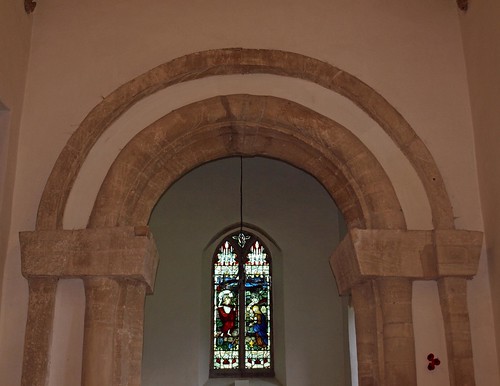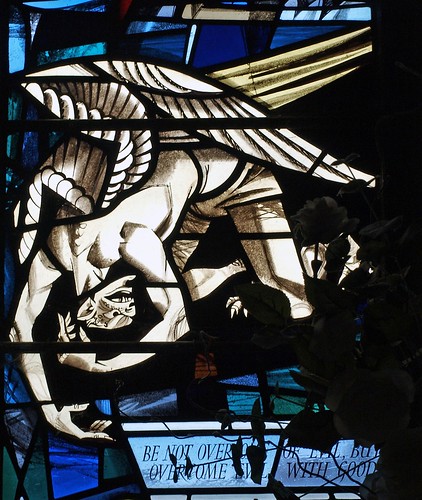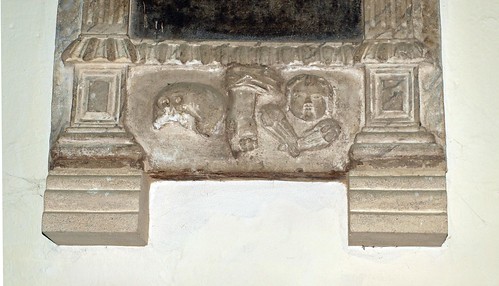The graveyard also has about 85 CWGC, mostly RAF, headstones which is far more than I've previously encountered in the area [obviously due to the adjoining RAF base]. In fact this area has the least amount of CWGC headstones than any other county I've covered.
ALL SAINTS. People who visit the church come to gaze at the Saxon chancel arch, which, in its cyclopean crudity, is without equal. A half-roll in the respond, a half-roll just outside the angle, a rectangular projection further out. Combined capital and abacus block 18 in. tall and tapering out towards the top but without any moulding whatever. The three mouldings or bands are carried on round the arch. It all makes even Barnack look refined. Yet of its rude force there can be no question. Perfect long-and-short work is preserved at the angles of the chancel and the nave (the NE angle to be seen inside). Mid C12 N arcade of two bays with big circular pier and square abacus. Many-scalloped capital. Similar triple-shafted responds. Arches with one big roll and an outer band of zigzag combined with lozenges and lozenges broken at r. angles. Late C13 W tower, see the pointed-trefoiled windows and the bell-openings of two lights with a quatrefoiled circle. Short spire with two tiers of lucarnes in alternating directions. Of about the same time the chancel S window and the S doorway of the nave. Early C14 N chapel, opening to the chancel in one arch of two chamfers, the inner on a head corbel. Early C14 also the tomb recess in the chapel. - STAINED GLASS. E window by Kempe, 1903.
WITTERING. For a thousand years it stood remote on a bleak upland between the Welland and the Nene, and all these years the work of the Saxons has remained untouched in the archway to its sacred altar. If there are any who believe that a thing cannot be simple and magnificent, let them come to Wittering and gaze upon its chancel arch.
Though the church has been refashioned by the Normans and the English builders who followed them, the simple nave and the low square chancel retain their ancient shape, and even in this county of famous Saxon towers we know of no piece of Saxon England more impressive than this massive chancel arch which looks today as it looked a thousand years ago, when its solid pieces were hewn into shape with rough axes, and these immense crude capitals were raised into their place. It is difficult to describe the sense of rude and overwhelming strength expressed in these huge blocks of stone, unchiselled, unworked, unadorned, masses of rock hewn out of the earth and brought to sanctuary in Alfred’s England. The arch rests on four pillars and has four orders, and it has the appearance of having been put together by primitive builders without any plan, yet put together with such strength and skill that in the warless world to come it may be standing in another thousand years.
The long and short work in the angles of both nave and chancel (some of it now within, owing to the addition of the north aisle and a chapel) is proof that this is the handiwork of the men who lived and died before the Conqueror set foot in England. The Normans came and added a fine arcade of two arches with zigzag and other bold carvings, and the 13th century English builders gave the church its tower and its bulging spire; they also built the porch with its deeply moulded inner doorway, and set windows in the south wall of the Saxon chancel, facing the pointed arch with two big queer faces on its moulding, one with a long tongue hanging out, the other with a veil across its mouth.
It is difficult not to be moved as we look at the simple stone of honour between the Norman and the Saxon arch in this small place, for on it one family name is repeated ten times, a witness to the devastation wrought by war in one small English village.
As we turn to take a last look at this fascinating little church, a tiny quatrefoil window not six inches across, so worn that it is almost round, seems rather like a human eye peeping out from the thick walls of the tower, and we notice against the outer wall of the church the coffin lid of a medieval priest.
Though the church has been refashioned by the Normans and the English builders who followed them, the simple nave and the low square chancel retain their ancient shape, and even in this county of famous Saxon towers we know of no piece of Saxon England more impressive than this massive chancel arch which looks today as it looked a thousand years ago, when its solid pieces were hewn into shape with rough axes, and these immense crude capitals were raised into their place. It is difficult to describe the sense of rude and overwhelming strength expressed in these huge blocks of stone, unchiselled, unworked, unadorned, masses of rock hewn out of the earth and brought to sanctuary in Alfred’s England. The arch rests on four pillars and has four orders, and it has the appearance of having been put together by primitive builders without any plan, yet put together with such strength and skill that in the warless world to come it may be standing in another thousand years.
The long and short work in the angles of both nave and chancel (some of it now within, owing to the addition of the north aisle and a chapel) is proof that this is the handiwork of the men who lived and died before the Conqueror set foot in England. The Normans came and added a fine arcade of two arches with zigzag and other bold carvings, and the 13th century English builders gave the church its tower and its bulging spire; they also built the porch with its deeply moulded inner doorway, and set windows in the south wall of the Saxon chancel, facing the pointed arch with two big queer faces on its moulding, one with a long tongue hanging out, the other with a veil across its mouth.
It is difficult not to be moved as we look at the simple stone of honour between the Norman and the Saxon arch in this small place, for on it one family name is repeated ten times, a witness to the devastation wrought by war in one small English village.
As we turn to take a last look at this fascinating little church, a tiny quatrefoil window not six inches across, so worn that it is almost round, seems rather like a human eye peeping out from the thick walls of the tower, and we notice against the outer wall of the church the coffin lid of a medieval priest.



No comments:
Post a Comment